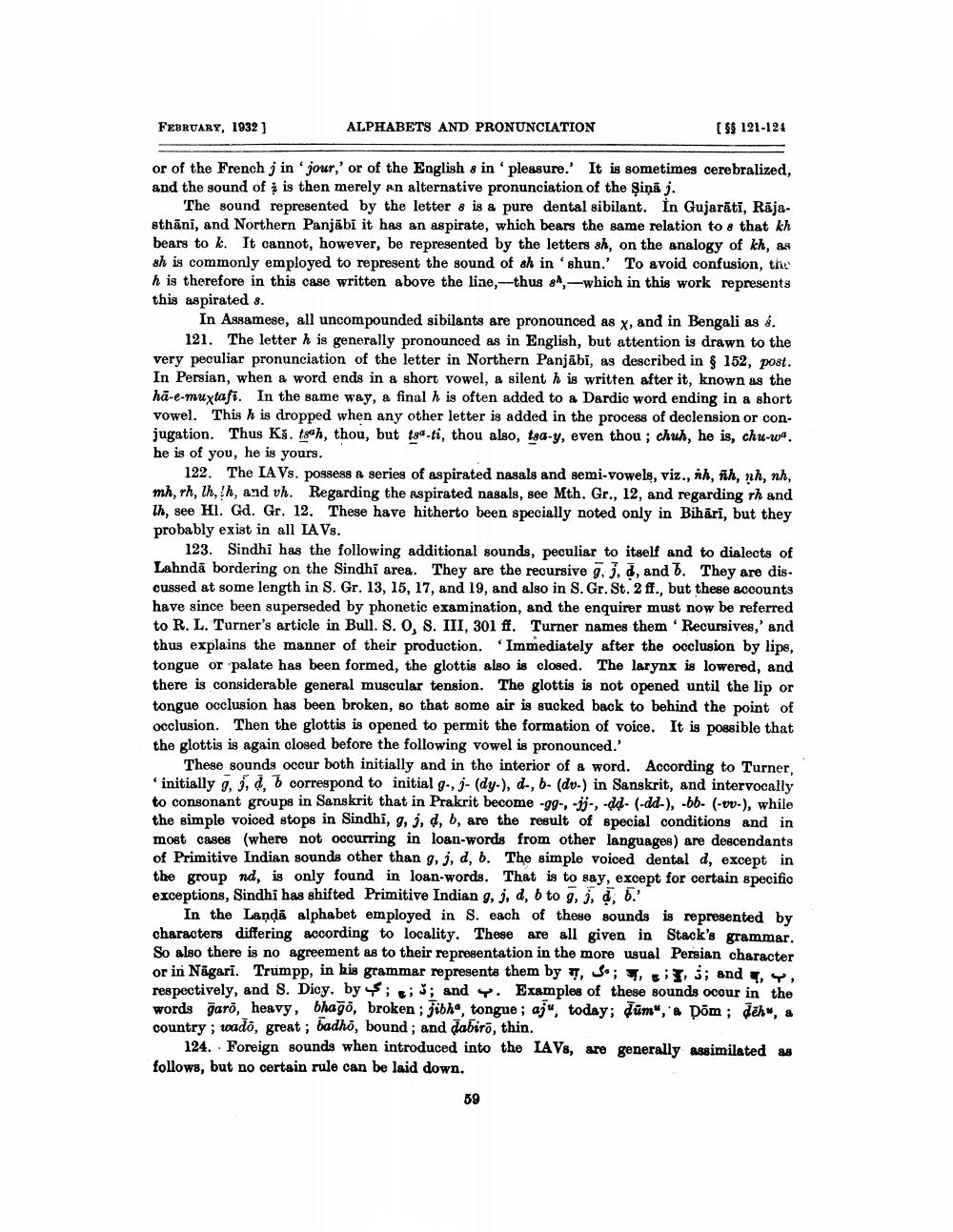________________
FEBRUARY, 1932]
ALPHABETS AND PRONUNCIATION
[§§ 121-124
or of the French j in 'jour,' or of the English 8 in 'pleasure.' It is sometimes cerebralized, and the sound of is then merely an alternative pronunciation of the Ṣiņā j.
The sound represented by the letters is a pure dental sibilant. In Gujarātī, Rājasthani, and Northern Panjabi it has an aspirate, which bears the same relation to a that kh bears to k. It cannot, however, be represented by the letters sh, on the analogy of kh, as sh is commonly employed to represent the sound of sh in 'shun.' To avoid confusion, the h is therefore in this case written above the line,-thus 84,-which in this work represents this aspirated s.
In Assamese, all uncompounded sibilants are pronounced as x, and in Bengali as . 121. The letter h is generally pronounced as in English, but attention is drawn to the very peculiar pronunciation of the letter in Northern Panjabi, as described in § 152, post. In Persian, when a word ends in a short vowel, a silent h is written after it, known as the ha-e-muxtafi. In the same way, a final h is often added to a Dardic word ending in a short vowel. This h is dropped when any other letter is added in the process of declension or conjugation. Thus Ks. tsah, thou, but ts-ti, thou also, taa-y, even thou; chuh, he is, chu-wa. he is of you, he is yours.
122. The IA Vs. possess a series of aspirated nasals and semi-vowels, viz., nh, nh, nh, nh, mh, rh, lh, !h, and vh. Regarding the aspirated nasals, see Mth. Gr., 12, and regarding rh and lh, see Hl. Gd. Gr. 12. These have hitherto been specially noted only in Bihari, but they probably exist in all IA Vs.
123. Sindhi has the following additional sounds, peculiar to itself and to dialects of Lahnda bordering on the Sindhi area. They are the recursive 7. 3, d, and b. They are discussed at some length in S. Gr. 13, 15, 17, and 19, and also in S. Gr. St. 2 ff., but these accounts have since been superseded by phonetic examination, and the enquirer must now be referred to R. L. Turner's article in Bull. S. O, S. III, 301 ff. Turner names them 'Recursives,' and thus explains the manner of their production. Immediately after the occlusion by lips, tongue or palate has been formed, the glottis also is closed. The larynx is lowered, and there is considerable general muscular tension. The glottis is not opened until the lip or tongue occlusion has been broken, so that some air is sucked back to behind the point of occlusion. Then the glottis is opened to permit the formation of voice. It is possible that the glottis is again closed before the following vowel is pronounced.'
These sounds occur both initially and in the interior of a word. According to Turner, initially g, j, d, b correspond to initial g-, j- (dy-), d-, b- (dv-) in Sanskrit, and intervocally to consonant groups in Sanskrit that in Prakrit become -gg-, -jj-, -dd- (-dd-), -bb- (-vv-), while the simple voiced stops in Sindhi, g, j, d, b, are the result of special conditions and in most cases (where not occurring in loan-words from other languages) are descendants of Primitive Indian sounds other than g, j, d, b. The simple voiced dental d, except in the group nd, is only found in loan-words. That is to say, except for certain specific exceptions, Sindhi has shifted Primitive Indian g, j, d, b to g, j, d, b.'
In the Landa alphabet employed in S. each of these sounds is represented by characters differing according to locality. These are all given in Stack's grammar. So also there is no agreement as to their representation in the more usual Persian character or in Nagari. Trumpp, in his grammar represents them by , J;,, ; and, Y, respectively, and S. Dicy. by;;; and. Examples of these sounds occur in the words garo, heavy, bhago, broken; jibha, tongue; aju, today; dum", a Dom; deh", a country; wado, great; badho, bound; and dabirō, thin.
124. Foreign sounds when introduced into the IAVs, are generally assimilated as follows, but no certain rule can be laid down.
59




